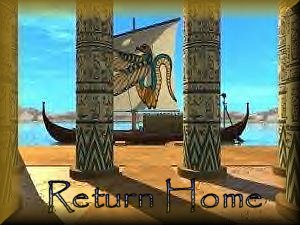
Akhet
This symbol represents the horizon... from which the sun emerged and descended back into. Both the beginning and end of each day was guarded by Aker, a double lion god. In the new kingdom, the god of the rising and setting sun was Harmakhet, which translates to read in English, "Horus in the horizon" He is usually depicted as a falcon or a sphinx, with the body of a lion. The great Sphinx of Giza is an example of Harmakhet. The symbol itself, is similar to the peaks of the Djew or mountain symbol with a solar disk in the center.

Alexandria

Akenaten
See Nefertiti

Amenta
This symbol represents the underworld, or land of the dead. Originally, it represented the horizon of the sunset. Later on, it became the symbol of the west bank of the Nile, where the sun set and also where the Egyptian traditionally buried their dead.

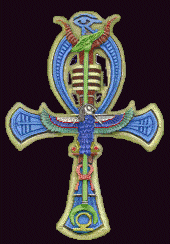
Ankh
The Ankh is a symbol in Egypt, which represents eternal life. It is used in hieroglyphics to write out the word "life". Egyptians would place the ankh up to a deceased persons' lips so that they may have one last breath needed for entry into the afterlife. It looks similar to a cross, with the exception of a loop at the crown of the symbol, (IE: 3 lines located west, east and south, with a loop at the north end.) The symbol is used on sarcophagi as well as incorporated into scribed wall paintings inside temples, kingdoms and tombs.

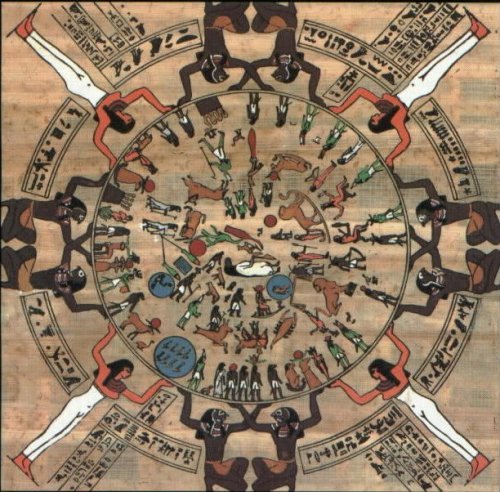
Astronomy

Amun-Ra

Aten
Sacred God which Akenaten, also known as Amenhotep IV, introduced to Egypt. Akenaten tried to make Aten the one and only god worshipped during the 18th dynasty. The aten is also a symbol, a solar disk (circle) with rays extending from it downwards and at an angle with flames on each ray. Upon Akenaten's death, the Egyptian religion soon returned back to the worship of Amon, the sun god Re.

Ba and Ka
The Ba is what we might call someones personality. It would leave the body at the time of death. During the daytime, Ba would make itself useful and return to the entombed deceased body again at night. At this time, it would look for the person which it belonged to... this would be the mummy, however, often the Egyptians would supply Ba with a statue in the likeness of the deceased in case the mummy was lost or damaged. Ka, which is similar to Ba, translates from Egyptian to read "Soul" or "spirit". The Ka came into existence when an individual was born. It was believed that the ram-headed god, Khnum, crafted the Ka on his potters wheel at the time of a persons birth. It was thought that when someone died, they met their Ka. A persons Ka would live on after a persons body had died. Some tombs included model houses as the Ka needed a place to live. Offerings of food and drink would be left at the tomb entrance so the Ka could eat and drink.

Bastet

Book of the dead

Cairo

Camel
When one would travel across the Sahara desert, one would need not only water but transportation, since the conditions of the Sahara are arid, treacherous and rugged.
A camel (Genus Camelus) is perfect for both needs. The reason is, the camel has humps in which they store water for long periods of time. This is why camels do not need to drink alot of water. A pack of camels is known as a caravan, as is a group of desert travelers.
There are two types of camels:
A - the one-humped camel (C. dromedarius) extant only as a domestic or feral animal; called also dromedary;
B - the two-humped camel (C. bactrianus syn. C. ferus) of Chinese Turkestan and Mongolia; called also Bactrian camel

Canopic jars
Canopic jars were jars made of limestone, alabaster, wood and pottery. The word canopic comes from the Greek name of the local god of canopus in the Nile Delta. Each canopic jar had a different stopper on it, all resembling animal heads. Each jar, 4 in all, represent the sons of Horus. They are as follows:
Imesty: The human headed guardian of the liver
Qebekh-sennuef: The falcon headed guardian of the intestines.
Hapy: The baboon headed guardian of the lungs.
Duamutef: The jackal or wild dog headed guardian of the stomach.
During mummification, the organs (Liver, Lungs, intestines and stomach) which were removed are placed inside these jars, then were placed inside the sarcophagus with the mummy.

Cat

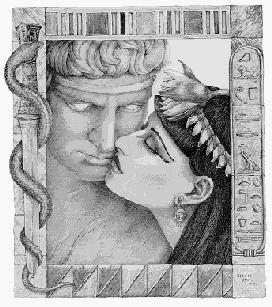
Cleopatra

Crocodile
The crocodile, as we all know, is similar to an alligator. The differences are the coloration as well as the snout and length of these two creatures. The Nile crocodile was feared in Egypt, because of the enormous size of the beast, which was comparatively larger than other crocs. The Egyptians believed that if you swam with the crocodiles and met one face to face, you would be judged by that crocodile. If you weren�t eaten, it was said that you were a worthy person by the crocodile�s judgment. Of course, if you weren�t worthy, you became lunch. People used to swim with the crocodiles on purpose in order to judge their life and achievements, since no crocodile was thought to eat those who were special.

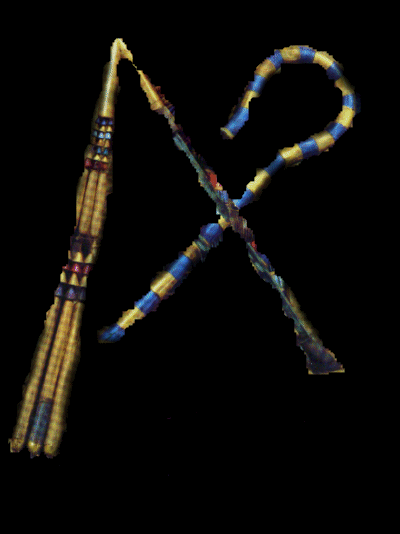
Crook and Flail
A symbol of royalty, majesty and dominion. The pharaoh grasps this in his hands when he comes to throne to rule. He holds it in such a manner that it criscrosses his chest, as seen on the sarcophagus of Tutankhamen. It is usually made of gold and donned with various gems such as turquoise and sardonyx.

Djed
It is believed the the Djed is the rendering of a human backbone. It represents stability and strength. It was originally associated with the creation god, Ptah, himself being called the "Noble Djed" A Djed column is often painted on the bottom of coffins, where the backbone of the deceased would lay. This identified the person with the king of the underworld, Osiris. It also acts as a sign of stability for the deceased' journey into the underworld.

Djew
Djew means mountain in Egypt, the symbol suggests two peaks with the nile valley in the middle. The ancient Egyptians believed that there was a cosmic mountain range which held up the heavens above them. This mountain had two peaks, the western was called Manu while the eastern was called Bakhu. It was on these two that heaven rested. Each peak of this mountain was guarded by a lion deity, who's job it was to protect the rising and setting sun. The mountain was also a symbol of the tomb and the afterlife, probably because most tombs were located in the mountainous land bordering the nile valley. In some ancient texts, we find Anubis, the guardian of the tomb being referred to as "He who is upon the mountain" Sometimes it is Hathor taking on the attributes of a deity of the afterlife. At this time she is called "Mistress of the Necropolis"
She is rendered as the head of a cow protruding from the mountainside.

Dreams

Edfu

Egypt

Feather of Ma'at
Represents truth, justice, morality and balance. It was pharaoh's job to uphold Ma'at. When a pharaoh died, Ma'at was lost and the world was flung into chaos. Only the coronation of a new pharaoh could restore Ma'at. It is written that the feather of Ma'at is weighed against a persons heart after death, to see if they are worthy of entering the underworld.

Fetish
An animal skin hanging from a stick, which sort of resembles a flag. A symbol of both Osiris and Anubis.


Giza

Hatshepsut
Born in the 15th century BC, Hatshepsut, daughter of Tuthmose I and Aahmes, both of royal lineage, was the favorite of their three children. When her two brothers died, she was in the unique position to gain the throne upon the death of her father. To have a female pharaoh was unprecedented. When Tuthmose I passed away, his son by the commoner Moutnofrit, Tuthmose II, technically ascended the throne. For the few years of his reign, however, Hatshepsut reined. From markings on his mummy, archaeologists believe Tuthmose II had a skin disease, and he died after ruling only three or four years. Hatshepsut, his half sister and wife, had produced no offspring with him (her daughter Nefrure was most likely the daughter of her lover Senmut), although he had sired a son through the commoner Isis. This son, Tuthmose III, was in line for the throne, but due to his age Hatshepsut was allowed to reign as queen dowager. She crowned herself as queen, which angered the young heir to the throne. She had the most statues of any queen in Egypt and was often depicted as a male pharaoh, wearing the traditional garb such as a Nemes as well as the false beard and held a crook and flail when she came to court. When Hatshepsut died and Tuthmose III came to rein, he defiled every statue and painting of her in a fit of anger and jealousy, as to erase her from Egypt's history. She was associated with the sun god Amon, frequently visited his temple and inside her own temple are the words of Khnum, the divine potter who sculpted the forms of the gods: "I will make you to be the first of all living creatures, you will rise as king of Upper and of Lower Egypt, as your father Amon, who loves you, did ordain." This assertion has validity, as other texts indicate. Her second conceit was more doubtful, however: she claims a direct divine lineage. As in the previous passage, she claims Amon is her father. On the walls of her tomb is inscribed a story detailing the night the Theban god Amon-Re approached Aahmes in the form of Tuthmose I.

Hieroglyphics
Hieroglyphics is the ancient Egyptian way of writing, using pictures instead of words and letters. While each glyph has a name and a certain way to pronounce it, the Egyptians used pictures to tell a story. The word hieroglyph is greek. Hiero means sacred and glyphe means carving, together to form "Sacred carving." When reading hieroglyphs, they can go in any direction on a page (right or left). You can tell which way to read them by looking at the glyphs themselves. If the glyphs all face a certain way (right for example) you would read the script from the left towards the faces... if they face left, then reading from the right would be correct. Hieroglyphs can be vertical on a page as well as horizontal and often times bleed into one another. (Ie: two small hieroglyphs on top of one another and one large at its side) Each hieroglyph represents a letter, though some represent names or whole words. The Nefer for instance is a circle with a line from its southern end with two lines across it horizontally on the southern line (sort of like the astrological glyph for Venus, with the exception of the extra line). This means beautiful. The ankh is another example, which translates to mean life.

Isis
Once ruled as Queen of Egypt. She was the wife/sister of Osiris, who was pharaoh of Egypt. When Osiris was killed, she sought to revive him back to life. She conceived a son by Osiris who was to avenge his father�s death. In a fit of anger in regards to his father�s death, her son Horus cut off her head, which was replaced by the gods with a cow�s head. Her unearthly image would not allow her to stay on Earth, so she ascended a giant ladder, made by Horus, with Osiris and Nephthys in company, to the heavens (known as Heliopolis) She was the goddess of Magic and was known for her good and pure ways as well as her ability to heal a person.

Khet
This symbol represents a lamp or brazier on a stand from which a flame emerges. Fire was embodied in the sun and in its symbol the uraeus which spit fire. Fire also plays a part in the Egyptian concept of the underworld. One terrifying aspect of the underworld which is similar to the christians concept of Hell. Most Egyptians would like to avoid this place with its fiery lakes and rivers that are inhabited by fire demons.

Menhed
A scribes pallet. Writing in ancient Egypt was very important. It was practiced by a group called scribes. The equipment for writing used by them consisted of a palette, which held black and red pigments, a water jar and a pen. To be a scribe was a favorable position, even some kings and nobles are shown proudly displaying scribe palettes.

Moses

Mummification
Mummification was the process of preserving the dead. The process itself was very gruesome. The deceased was laid on a mummification table, usually symbolized by the cats that were interwoven and incorporated on it, after it was soaked in herbs and oil for several days. Once dry, the body was then split vertically from the jugular (neck region) all the way down to the groin area above the pelvis. The innards were removed. All the organs, except the heart, which remained intact, were placed in canopic jars, to be later placed inside the sarcophagus when finished. The process of removing the brains was also very gruesome; a wire hook was placed up into the nostrils, the hook was then moved around vigorously to mash up the brains inside and then they were pulled out of the nostrils. Among the organs kept were: Lungs, Liver, intestines and stomach, 4 organs in all, one for each canopic jar. The heart was not removed, though it was said to be weighed against the feather of Ma'at to see if an individual was worthy of entering the underworld. When all the inner parts were removed and stuffed with herbs and dried flowers, it was then wrapped tightly in gauze, with the arms crossed in front of the corpse, such in the way the pharaoh stood with crook and flail. Mummification is still practiced today and not only on humans, but on animals as well.

Mummy

Naos
A shrine in which statues were kept, especially in temple sanctuaries. A small wooden naos was normally placed inside a monolithic one in hard stone; the latter are typical of the late period and sometimes were elaborately decorated. Also used as a term for temple sanctuary.

Nebu
This symbol represents gold which was considered a divine metal. It was thought to be the flesh of the gods, which is why the Egyptians used Gold as settings in jewelry and amulets. Its polished surface was related to the brilliance of the sun. Gold was important in the afterlife as it represents immortality. By the new kingdom, the royal burial chamber was called the "house of gold."


Nefertiti
She ruled Egypt as Queen. Her name translates from Egyptian to English to say "The beautiful one is come" which she later changed to Neferneferuaten-Nefertiti or "The-Aten-is -radiant-of-radiance [because] the-beautiful-one-is come". A different interpretation of the name change, translated Neferneferuaten to mean--"Perfect One of the Aten's Perfection". The pharaoh to whom she was wed was Akenaten, which translates to read "He who is of service to Aten" born Amenhotep IV "The god Amun is at peace" Akenaten was a very odd pharaoh who ruled the eighteenth dynasty and perhaps he was the most bizaare of all. Aside from being depicted as a woman becuase of his odd shape, which was rumored to be due to a disease he had, later denounced once his remains were exhumed, he began a radical movement of a new religion which would worship only one god instead of a pantheon of netjeru. He went as far as to desecrate anything and everything which depicted Amon as god as well as erasing anything which referred to netjeru instead of Aten alone. Nefertiti stood behind her husbands visions of religion and together they held 3 ceremonies a day worshipping their god, one in the morning, one in the afternoon when the sun was high overhead, and one after sunset. His attempts at this new religion failed and soon the religion returned to what it was prior to his rein, following his death. Nefertiti soon disappeared. The events surrounding her disappearance is a mystery, since no one has found her remains. All that remains is a famous bust which was made in her semblance. It is possible that she disappeared on her own behalf, to retreat to worship their one god which they deemed so powerful, as much as its possible that she was murdered or sacrificed, perhaps by Akenaten himself. The god they worshipped was known as Aten, for which Akenaten is named in honor, depicted as a sun disk with rays extending downwards and at an angle, with flames on the end of each ray. Akenaten had ties to Tutankhamen who is rumored to be Akenatens son, but the truth to this is unknown. Akenatens remains have disappeared, some say the priests of Amon destroyed it to prevent him going to the afterlife.

Nemes
A striped headcloth worn only by pharaohs. On Tutankhamens sarcophagus, or rather his funeral mask, he wears this headdress, which is usually golden yellow and bright cobalt blue in color and features a uraeus on the front center of the nemes which sprawls upward to protect the forehead of Pharaoh.

Netjer
Translates to read "divine power." A netjer in common terms is another way of saying god or goddess, more simply yet misleadingly so. There are thousands of these figures in Egyptian mythology, some greater and some lesser, but all worshipped by the Egyptians.

Nephthys
She was the Egyptian netjer of the dead, sister/consort of Set who was in love with Osiris, also her brother. She tricked Osiris into copulation and conceived a child by him, Anubis. She abandoned Anubis by the River Nile, who was later found there by Isis. Isis took Anubis as her own. When Set killed Osiris, Nephthys helped Isis prepare the rite to revive Osiris from the dead. Before the operation could be carried out, Set stole Osiris' body and chopped it into 14 pieces and then tossed it in the Nile River. In order for the rite to work, all pieces of the body would need to be obtained and only 13 were found. The last piece (the genitals) was ingested by a Nile crocodile. Nephthys was deemed the goddess of the dead because she comforted the newly deceased in the underworld.

Nile River

Orion's belt


Osiris
Once pharaoh of Egypt, brother/husband of Isis. His brother set was very jealous of his reign as pharaoh as well as the fact that his wife Nephthys was in love with Osiris and not himself. She conceived a son by him named Anubis. In greed and rage, he tricked and entombed Osiris in a coffin, which was set to sail on the river Nile, so that he could take over as pharaoh. Isis and Nephthys sought the coffin of Osiris and attempted to revive him. Before they could, Set stole the remains of Osiris and chopped them into 14 pieces, only 13 of which could be found. Without the other pieces, Isis could not revive him. His son Horus avenged him and brought him back to life by feeding him his eye that Set had ripped from the socket. Horus built a giant golden ladder for them to ascend to heaven from Earth. Osiris remained in the underworld and was appointed judge of the dead. He chose who was admitted to the underworld and rejected those who weren�t of pure soul.

Papyrus

Pet
The symbol depicts the sky as a ceiling which drops at the ends, the same way the real sky seems to reach for the horizon. This sign was often used in architectural motifs; the top of walls and door frames. It symbolizes the heavens.

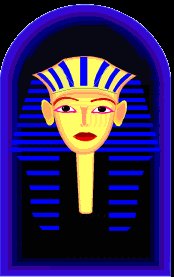
Pharaoh
A King in Egypt. There were several pharaohs, each ruled during different dynasties. Some reigned northern Egypt and some reigned southern. You can tell which part they reigned by the crown they wore. The descendants of the King ruled when the king died. Of all the pharaohs, there's only one who was Female. Hatshepsut was she, the first and only female pharaoh (see Hatshepsut)

Pyramid
A pyramid is a triangular structure that was made by slaves in ancient Egypt. The reason they made the pyramid shaped like that was because it was thought that the Ka and Ba, or the soul of a person whom had deceased, would be "shot" so to speak, from the depths below and up into the sky. Pyramids were constructed for Pharaohs, though not all of the pharaohs were buried in them. Tutankhamen was buried in the Valley of the Kings as to confuse grave robbers so they could not steal his jewels and valuables places in his sarcophagus. Many other pharaohs were buried there as well. The pyramids of Giza, which are three in all, are perfectly aligned with the 3 stars that make up Orion's Belt. It was thought that, during a certain time of year, these stars would align would the 3 pyramids of Giza and bring back Osiris, who they believed the constellation of Orion truly was. When they aligned, the starlight would shoot into vents that were installed in the pyramid and resurrect the pharaoh from the great beyond.

Sa
Another symbol of protection. Its origins are uncertain, but its speculated that it represents either a rolled up herdsman shelter or a papyrus life preserver used by ancient Egyptian boaters. Either way it is clearly symbolizing protection. From early times the Sa played an important part in jewelry design. It is often used in conjunction with symbols, particularly with the ankh, Was and Djed signs. We often find Taurt, the hippopotamus goddess of childbirth, resting her paw on a Sa sign.

Sacred Lake

Saqqara
More commonly known as the city of the dead. King Djoser was the pharaoh whom this elaborate underground tomb was created for. He constructed it and now resides there in the Djoser step pyramid, a pyramid unlike any other in Egypt.


Scarab
A symbol that represents spontaneous creation. The scarab beetle is a type of dung beetle, called that because it rolls dung across the ground, this behavior the Egyptians observed and equated with the ball of the sun rolling across the sky. The Scarab beetle burrows itself beneath the sands of the Sahara. Here it lays eggs and when the babies hatch, they crawl out from in the ground and search for food. To a person viewing such an event as this, it seems to them that thousands of beetles just scurry out from in the ground, out of nowhere, hence the spontaneous creation theory. In this role it was associtated with the sunrise. Khepri was the scarab headed god, thus the scarab itself is sometimes referred to as Khepri.

Sekhem
A symbol of authority. May be seen with Kings as well as royal guards and protectors.


Sesen
Sesen is the Egyptian name for the Lotus flower, which has symbolic meaning similar to the scarab beetle. When the tide from the river Nile comes in the flowers are submerged beneath the water of the Nile. When the tide ebbs again, the flowers appear from out of nowhere. They represent rebirth in Egypt. The blue lotus is associated with the Nile and thus with fertility. It is also an emblem of immortality. The ancients used it for funerary rites, especially for women and children. In ancient wall paintings, Osiris was often portrayed wearing lotus headresses and Horus often sat upon a lotus as a throne. In Egypt, the lotus floating on the water of the Nile represented the newly created Earth.The lotus flower is a Nymphaea Lutea (or Nymphaea Lotus), a type of water lily, usually white or light pink in color, though variations do occur.


Set (or Seth, Seti)
Beastly-headed demon of the underworld, comparable to Satan in Christianity. He killed his own Brother Osiris in a fit of jealousy and rage. His sister/wife Nephthys had an affair with Osiris, whom she loved more than her husband and conceived Anubis by Osiris. Set lured his brother by having a celebration in his honor. He had a coffin made for the party that was perfectly made to Osiris' proportions. The servants brought the coffin out at the party and Set stated whoever fit the coffin perfectly, it would become their own. One by one everyone tried and failed, for it was made for the pharaoh himself. When Osiris tried and got in it, Set slammed the cover down over him and trapped him inside, then set him adrift on the river Nile. Set was later slain by Horus, Osiris' son, who sought revenge against his uncle for the death of his father, the pharaoh, though not before Set ripped Hours' eye right from his socket in the heat of battle.

Shen
A loop of rope that has no beginning and no end. A symbol of Eternity. The sun disk is often depicted in the center of it. The shen seems to be a symbol of protection and is often seen being clutched by Netjeru in bird form, such as Horus the falcon and Mut the vulture, hovering over pharaoh's head with their wings outstretched in a protective gesture. The word shen comes from shenu which means, "encircle," and in its elongated form became the cartouche which surrounded the king's name.

Shenu
More commonly known as a catouche. The shape represents a loop of rope in which a name is written, and acts as a protector of that name. Cartouches are usually made from stone, though really they can be made from anything. They are often painted or carved and are adorned with other various symbology.

Sistrum
A percussion instrument used in the cult of Hathor. The sistrum consisted of a wooden or metal frame fitted with loose strips of metal and disks which jingled when moved. This noise was thought to attract the attention of the gods. There are two types of sistrum: an Iba, which was shaped in a simple loop like a closed horseshoe with loose crossbars of metal above a hathor head and a long handle. The second type, the seseshet, had the shape of a naos temple above a hathor head, with ornamental loops on the sides. The rattle wa sinside the box of the naos. They were usually carried by women of high rank.

Solar winged disk
The form in which horus often appeared as, when he would battle Set. The symbol itself is the circle of the sun in the center with wings outstretched on each side. Oftentimes, Nekhbet and Uazet join this symbol in the form of Uraeus snakes on each side of Horus.


Sphinx

Sun
The sun was worshipped in Egypt. The entire Egyptian culture revolved around the sun. The sun god Amun-Ra, comparable to Zeus in the greek panthenon, is the most powerful and head of all the Netjer in Egypt, also known as the sun god Re. There were other sun gods in Egypt as well as gods whom protected the rising and falling of the sun in the horizon. Everything in Egypt, be it jewelry, amulets, wall paintings or shrines, was adorned with a sun disk, sometimes with rays extending outwards but usually a circle by itself. Sometimes the circle contained a dot in the center, as in astrology, the symbol which represents the sun is a circle with a dot in the center as well.

Tiet
The origin of this symbol is unknown. In many respects, it resembles an ankh, except that its arms curve down. Its meaning is also reminiscent of the ankh, it is often translated to mean welfare or life. As early as the third dynasty we find the tiet being used as decoration when it appears with both the ankh and the djed column and later was with the scepter as well. The tiet is associated with Isis and is often called"the knot of Isis" or "the blood of Isis." It seems to be called the first because its used to secure the garments that the netjeru wore. The second meaning is more obscure but it was often used as a funerary amulet made from red stone or glass. In the later period the symbol was associated with the following netjer: Nephthys, Hathor and Nut. In all the cases it seems to represent the ideas of resurrection and eternal life.

Tutankhamen
A young pharaoh of Egypt who came to reign at a mere 9 yrs old and died shortly thereafter at the young age of 18. Tutankhamen translates from Egyptian to say in English "the living image of the god himself" and is pronounced: Toot ahnk ah men. The pyramids of Giza were constructed for this pharaoh, for his remains to reside in once he died. However, he was not placed inside the tomb, but instead was entombed in the Valley of the Kings, as were other pharaohs. This was done because of tomb raiders, to confuse them so they could not steal the sarcophagus or the items, which were inside. King Tut reigned from 1333 to 1323 BC, during the 18th dynasty. He was the son-in-law of Akhenaton, whom he succeeded, and possibly his son by a minor wife. Peace was brought to Egypt during his reign as the worship of Amon, abandoned under Akhenaton, was restored and Thebes, the city sacred to Amon, was again made Egypt's capital. Although he was not an important king, Tutankhamen is well known today because his tomb, containing fabulous treasures, was found virtually intact by the British archaeologists Howard Carter and Lord Carnarvon in 1922..

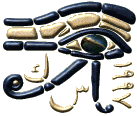
Udjat
Udjat is the Egyptian word for "Sound Eye" which clearly defines the Eye of Horus.
The eye of Horus came to be when the god Horus fought his uncle Set to avenge his father�s death caused by Set. During the battle, which lasted 70 yrs, Set ripped Horus' eye from its socket, which was a turning point in the battle itself. Since it angered Horus so badly, it inspired him, more or less, to rise up to the challenge he had previously been losing. Later, after Set was defeated, Horus fed his eye to Osiris, which brought him back to life. The symbol came to symbolize protection from enemies, that the all Seeing Eye itself would see evil and take on its own form to swoop down and smite those who were wicked. It also symbolized healing as well. There are three ways to view the eye of horus, 3 ways it is depicted as well. Right alone, left alone or both eyes together as a pair. This is because the eye of horus is assembled in sections, 3 in all, with 1/64 missing, which was believed to be replaced by the God Thoth through magic. The medicinal symbol for prescriptions (Rx) is derived from the 3 pieces of the eye of horus. The right eye is usually white in color, representing the sun. The left eye is usually black and represents the moon. The eye is also used in funerary rituals. The book of the dead instructs that the eye must be made from a stone known as Mak, which translates to "Lapis Lazuili" if it was to be used for necromantical and funerary purposes. It was usually set in gold or gold plating.


Uraeus
The cobra is a symbol of lower Egypt and is associated with the sun and many other Netjer. The cobra represented the "fiery eye of Re" in which two uraei can be seen on either side of a winged solar disk. Crowns worn by royalty whom ruled lower Egypt, have donned upon them either several small cobras (this one is the crown of Queens and consorts) or one large one centered to the forehead, sometimes accompanied by the vulture headed goddess, Nekhbet (A uraeus is also often incorporated onto the forehead of the striped headdress worn by pharaoh called a Nemes) One example of the latter would be the funerary mask of Tutankhamen. Cleopatras crown had also uraei. The egyptians believed that the cobra would spit fire at any approaching enemies.

Ushatbi
This translates to english to mean "to answer." Its a small mummification figure placed in tombs to do work in the afterlife on bahlf of the deceased. In some tombs of the late new kingdom whole gangs of ushatbi wprkers were included with different tools for doing different work. A complete collection would consist of 401 ushatbi: one for each day of the year, 365 plus 36 foreman.

Valley of the Kings
A burial field composed of rugged mountainous terrain, with a series of tombs underground. This is where most of the pharaohs of Egypt were laid to rest, but only pharaohs were allowed to be buried here.

Wadjet
Translates to read "she who is green" this netjer rules cobras and is depicted as being a cobra herself, either in full body or depicted as the head alone, often donned on crowns of royalty. She is associated with lower Kemet and wadjet is also often symbolized on the red crown of lower Egypt. Wadjet is often accompanied by Nekhbet, the vulture headed netjer of southern Egypt, which symbolizes one half of the two lands that make up Kemet politically.

